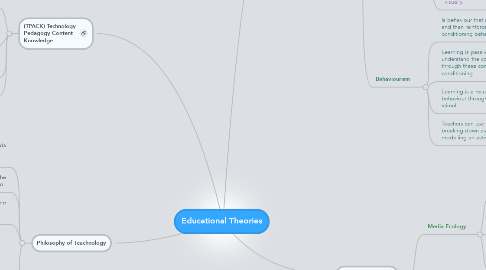
1. Technology Theories
1.1. Media Ecology
1.1.1. is the effect of media on environments
1.1.2. What is the role that media plays in shaping the human environment? How is media changing the way humans interact and go about their business on a day to day basis?
1.1.3. How does media change the educational environments? Technology is ever changing the way we learn, think, and teach. How is the classroom environment effected by media?
1.2. Social construction of technology (SCOT)
1.2.1. humans shape technology (technology does not shape humans)
1.2.2. can be used to measure the success and failure of a technology through its social values
1.2.3. As a teacher, we are evaluating what technology holds meaning to learning in the classroom environment
2. Learning Theories
2.1. Connectivism
2.1.1. Is a way of learning outside of self by being plugged into networks, communities and databases
2.1.2. Various knowledge and information is available for the learner to find
2.1.3. Educators should provide opportunities for their students to explore and interpenetrate knowledge they find using technology
2.2. Constructivism
2.2.1. Is the theory that new knowledge is built upon old knowledge. Previous knowledge and experience is critical to reception of new information
2.2.2. Collaboration allows learners to come together to share their experiences and knowledge
2.2.3. Knowledge is a receptive way of learning from others
2.2.4. Educators use constructivism to produce "expert learner" by teaching students how to learn by investigating and exploring new information, testing it, and drawing conclusions.
2.2.5. Authentic learning gives responsibility to the learner to direct and maintain their own learning
2.3. Cognitive Load
2.3.1. Information processing between working memory and long term memory
2.3.2. To learn something, long term memory must be altered in some way for the information to be stored
2.3.3. In coming data <-> working memory <-> long term memory
2.3.4. 3 cognitive loads : Extraneous (structures that prevent working memory to build schemas for long term memory), Intrinsic (the interaction of working memory), and Germane (schema construction and automation)
2.3.5. Teachers need to be aware of the 3 cognitive loads and its effects on learning so they don't overload their students with new information. Information needs to be chunked (compression of knowledge), repetitive and demonstrate concise fomating that is easy to follow visually.
2.4. Behaviourism
2.4.1. Is behaviour that starts with a stimuli, response and then reinforced stimuli. It is a way of conditioning behaviour.
2.4.2. Learning is passive. The learner must be able to understand the connections presented. It is through these connections that they learn, like conditioning.
2.4.3. Learning is a result of a change in behaviour through a response to a stimuli
2.4.4. Teachers can use behaviourism through direct teaching by breaking down assignments into smaller manageable tasks or by modelling an activity by explaining and demonstrating information.
